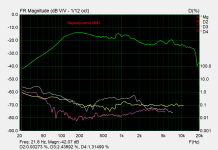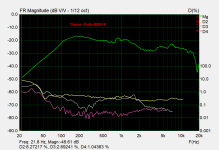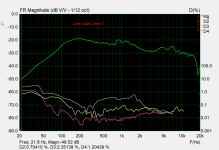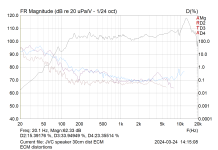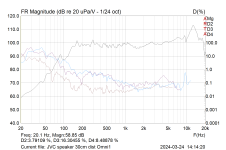I have some more information for you;To be honest, the problem with standards is that everyone has their own standards.
AFAIK, Brüel & Kjær spec their capsules at 3% THD, and peak SPL at 10% THD.
Here's what I've gathered so far study on microphone capsules / phantom powered microphones:
In no particular order...
�
EMM-6
https://www.pcb.com/contentstore/MktgContent/LinkedDocuments/Reports/3P03218condensedreport.pdf
Attachments
I found this interesting item wrt HIGH SPL calibraton of microphones: https://bswa.oss-cn-shanghai.aliyuncs.com/202309/20230912143350179.pdf It does not look too difficult to make if somneone can work through the math. Use a compression driver to drive it.
Well here is something interesting.
Since I have some work coming up this week and most of my stuff is STILL in moving boxes, I though you know what, let's just do a fun comparison since I have everything out anyway.
This is all measured at 95±3 mm distance, with a sampling rate or 44.1kHz and a sequence length of 64k (important! )
Mics in this test:
Amplifier: LM3886
SPL was later checked and calibrated with the Dayton EMM6 with a B&K 4230 (just because of no particular reason) at a 115dB peak @ 95mm.
Although I will do another proper check again to make sure.
It doesn't really matter, it's about the relative differences! (but nice to have the right numbers there
(but nice to have the right numbers there  )
)
Speaker: no idea, some kind of Kenwood cheapo whatever, the rest is still in moving boxes
Don't pay attention to the exact differences at the higher frequencies, except for the distance, the mics were NOT 100% exactly lined up (so above a certain frequency you will see differences)
But hello H2/D2/K2, didn't see you coming.
The effect is much worse at even higher SPL's, will show you after dinner or so
btw; pixel peeping will be punished! ☝️
Since I have some work coming up this week and most of my stuff is STILL in moving boxes, I though you know what, let's just do a fun comparison since I have everything out anyway.
This is all measured at 95±3 mm distance, with a sampling rate or 44.1kHz and a sequence length of 64k (important! )
Mics in this test:
- Dayton EMM6
- Beyerdynamic MM1
- Line Audio Omni 1
Amplifier: LM3886
SPL was later checked and calibrated with the Dayton EMM6 with a B&K 4230 (just because of no particular reason) at a 115dB peak @ 95mm.
Although I will do another proper check again to make sure.
It doesn't really matter, it's about the relative differences!
Speaker: no idea, some kind of Kenwood cheapo whatever, the rest is still in moving boxes
Don't pay attention to the exact differences at the higher frequencies, except for the distance, the mics were NOT 100% exactly lined up (so above a certain frequency you will see differences)
But hello H2/D2/K2, didn't see you coming.
The effect is much worse at even higher SPL's, will show you after dinner or so
btw; pixel peeping will be punished! ☝️
Attachments
Last edited:
I guess you refer to the low figures of the Line Audio eh? @ScottG has pointed that out a while ago. Here’s my quick and dirty comparison of the Omni1 and an ECM8000 from a while ago.
Oh I didn’t calibrate SPL here.
Oh I didn’t calibrate SPL here.
Attachments
Last edited:
If the circuitry inside the mic itself has proper regulation, this is not a problem at all.I wonder how much of the LF distortion is Phantom power circuitry compromises. Phantom power has always struck me as a compromise for convienence. One very difficult to maintain down to very low frequencies.
That being said, I also don't understand why we are still working with an ancient old standard that makes very little sense. Al major mic brands have their own power supply solution for this reason.
For phantom power stuff; just get rid of those silly 6k8 resistors, and give a proper regulated power supply and everyone is happy
Well not really, the Beyerdynamic and Line Audio are similar.I guess you refer to the low figures of the Line Audio eh?
Only the H2 of the cheap Dayton mic shoots up like crazy, while H3 stays basically the same between all of them.
I will try STEPS as well, especially with the higher harmonics.
Speaking of which, is swear that ARTA also used to do higher harmonics? 🤔🤔
Phantom power works perfectly well with mic circuits which are built for it. Most older circuits only use 2mA current and you have big buffer caps and some regulation. No problem at all. And when you take into acount the nature of music signals ... it get's even easier.I wonder how much of the LF distortion is Phantom power circuitry compromises. Phantom power has always struck me as a compromise for convienence. One very difficult to maintain down to very low frequencies.
Phantom power is KEY to the practical use of condenser microphones in everyday life of sound engineers all over the globe in all use cases. There are very little mics with external power supply and they are a hassle. Of course you need it for tubes ...
(yes, I built electronics for AKG. I like my phantom power supply
it's just old legacy in combination of being cheap IMOPhantom power is KEY to the practical use of condenser microphones in everyday life of sound engineers all over the globe in all use cases. There are very little mics with external power supply and they are a hassle. Of course you need it for tubes ...
In the end it's just a power supply with a very bad output impedance.
Just put a nice little current protected voltage regulator at the outputs and it works an awful lot nicer.
I have done this a bunch of times for some lab test setups.
Works so much better, supply voltage is so much cleaner, literally costs cents more.
It reminds me a lot why active (acoustic) guitars also still use freaking batteries.
While they would work perfectly fine (even better) with a phantom power circuit.
My concern re phantom power related to too small supply caps and/or too small coupling caps that don't match adding common mode at low frequencies. These are all overcomeable but not at lowest cost. The electret may also have issues at low frequencies although less likely and there may be acoustic and microphonic issues in the mike. Getting all this right is not real cheap and why Earthworks, GRAS and B&K are pricey.
The reason why they are pricey, is because they serve a professional market.why Earthworks, GRAS and B&K are pricey.
Where often paperwork and guarantee is worth most of the price.
Meaning that they can blindly trust the quality and results not for themselves but also for potential technical claims etc
Besides the fact that it's market where there is money.
I think the only exception is the real serious stuff, which is being used very specialized acoustics.
Loudspeakers are just cute compared to that.
You are paying for more than some documentation. There is a lot of performance testing and validation under extreme conditions and with GRAS and B&K metal diaphragm mikes an expectation of constant repeatable performance over decades. Doing temperature, pressure, vibration, shock testing isn't trivial. Having the traceable calibration is an expensive overhead as well. I agree its not needed for amateurs. A mike with known frequency response (+/- 1 dB) is more than enough. I have over a dozen metal diaphragm mikes and I use a Panasonic wm61-a for most of my measurements. The others are for special applications and calibration verification. And they have nice mahogany boxes.
Having worked in the field of special acoustics (but it also counts for electronics), you sometimes quite literally pay for paperwork.You are paying for more than some documentation
Obviously the paperwork still has to be written, and therefore costs time = money.
But often that is what validation is all about.
The validation experiment and test often only takes 10 min in some cases.
The time and money spend how and why to execute these tests, is just simply divided by the amount of tests you do.
From a economics point of view that is the same as putting time and effort in designing a product and selling it.
Depending on how much you're selling that time and effort can be totally negligible relatively speaking.
Meaning the price of a product is barely affected by it.
Anyway, I said that I don't disagree with you when it comes down to special fields, like blast or underwater acoustics etc.
But for audio acoustics most (not all) things are relatively simple.
Some microphone brands don't even design and engineer the capsules and only design the electronics (preamp) and looks around it.
Earthworks isn't in the same league as B&K/DPA, Gras orMicrotech Gefell. The latter all produce lab grade stuff, separate preamps, +200V systems. Earthworks is more of a regular mike brand that happens to build a few (nice) measurement omni's. No IEC 61672 class specs, mainly a straight response curve. Wouldn't call them really pricey either. I believe it to be a public secret that they use off the shelf microphone capsules, likely from China (nothing being wrong with that).Getting all this right is not real cheap and why Earthworks, GRAS and B&K are pricey.
@markbakk
What I mostly wanted to show with these measurements btw, is the similarity with a lot of other measurements.
Sometimes you can clearly see a lot of 2nd order distortion around the same frequencies.
(I can show an example later)
Which makes you wonder if you're looking at the distortion of the woofer or just the mic?
I have seen cases where it just didn't make a lot of sense.
On the other hand (counter argument), it also make no sense why this would be a bigger issue at those frequencies and/or not the same with similar woofers (since they provide the same amount SPL)
What I mostly wanted to show with these measurements btw, is the similarity with a lot of other measurements.
Sometimes you can clearly see a lot of 2nd order distortion around the same frequencies.
(I can show an example later)
Which makes you wonder if you're looking at the distortion of the woofer or just the mic?
I have seen cases where it just didn't make a lot of sense.
On the other hand (counter argument), it also make no sense why this would be a bigger issue at those frequencies and/or not the same with similar woofers (since they provide the same amount SPL)
You mean no OFFICIAL IEC 61672 certification.No IEC 61672 class specs,
Even a ECM8000 will fall within these IEC norms. (Class 2 probably, they used to have even Class 3)
Any Earthworks mic, falls well within these norms.
Again, this is pure paperwork, where you have to get your microphone officially checked by a notified body to get it officially certified.
Outside noise and architectural acoustics, especially when there are all kinds of legal regulations involved, I have never seen much purpose of this particular IEC norm btw.
- Home
- Loudspeakers
- Multi-Way
- Distortion in Measurement Microphones - actual measurements
